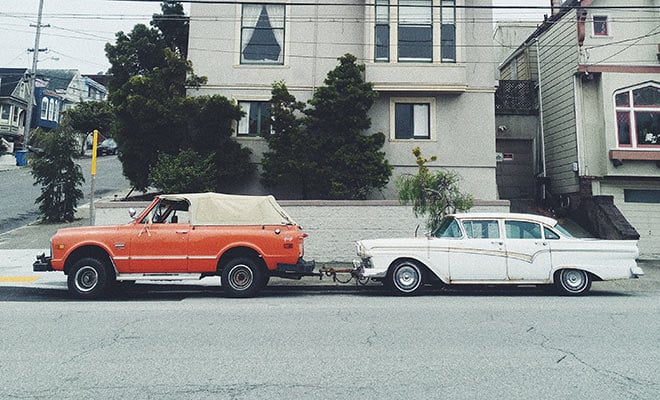What Does Stacking Your Car Insurance Mean and Should you Stack Yours?
You may have heard the term “stacking” in relation to your car insurance, but what does it mean to stack your insurance, and should you be doing it? Auto insurance is complex and full of jargon that can make it challenging to know what to do.
But stacking does not have to be complicated, and since it can benefit you, it is important to understand how it works. Unexpected things happen all the time, and car accidents are no different. Stacking your car insurance can provide additional protection against the unexpected.
Read on to learn about stacked vs. unstacked car insurance and how the experts at Compare.com can help you make the right decision for your situation.
Stacked vs. Unstacked Car Insurance: Which is Better?
Whether stacked or unstacked car insurance is better for you depends on your situation. If you carry high limits or only have one vehicle, unstacked car insurance may be a better option for you.
Whether stacking is allowed is determined by each state, so you may not live in a state that allows stacking. There are about 30 states that currently allow some form of stacking car insurance.
Low Limits and Uninsured Drivers
If you live in a state where the minimum liability limits are low, you may want to consider stacking your limits. This is because if you are injured by a driver carrying only low limits, you are more likely to need to come back to your policy for additional coverage. In that case, stacking your limits could benefit you.
The Insurance Research Council notes one in eight drivers are uninsured. Some states have higher percentages of uninsured drivers than others – almost 27% of Florida drivers are uninsured; Mississippi has 23% uninsured; and New Mexico, Michigan, and Tennessee each have 20%.
Being injured by an uninsured driver means your uninsured motorist limits are in play. If your injuries are severe, having stacked limits can help protect you.
What is Stacked Car Insurance?
In insurance, stacking refers to the ability to combine the limits of two or more applicable auto insurance policies for a single incident. If there is more than one auto policy in force at the time of loss, stacking those policies’ limits may be possible in some circumstances.
Stacking in car insurance refers to the uninsured motorist liability limits. This coverage is available to you if you are involved in an accident with an uninsured driver or underinsured driver – meaning they only carry low or state minimum limits.
The risk is that these low limits carried by other drivers may not be enough to cover all your damages if you are injured in an accident caused by the other driver. In that case, your policy can be triggered, and you may need all the coverage possible to help with your damages.
Anti-Stacking Provisions
Some policies carry anti-stacking provisions to disallow the stacking of limits for single-occurrence events. These provisions can be written into the policy itself, or they can be the result of state legislation – in that case, included in the state’s motor vehicle code.
If your carrier does have an anti-stacking provision in place, that will eliminate stacking, even if it’s allowed by your state. If you want to stack your car insurance, but your current carrier does not allow it, you may want to shop around and compare your options to find an insurance provider that allows for stacking.
The Cost of Stacked Car Insurance
Stacked car insurance tends to carry a higher premium than unstacked policies. This is because your coverage limits are greater once stacked, so you must pay more for that higher limit. The coverage is valuable though, so you may consider the additional premium a necessary expense.
However, many auto insurers provide a multiple vehicle discount that can be up to 30% in some instances. By insuring more than one vehicle on your policy, you could receive this multiple-vehicle discount and offset some of the increased premium owed for the stacking provision.
How Stacked Car Insurance Works
Stacking policy limits can work in two different ways – if you have one policy with coverage for two or more vehicles under the same policy or two different vehicles’ policies. With two or more policies, all must be in your name in order for you to be able to stack the limits.
Some states limit the number of vehicles on the same policy that may be stacked. Other states allow anti-stacking provisions to be added to individual policies at the insurance carrier’s discretion, even when the state itself allows stacking.
One Policy, Multiple Vehicles
The liability limits under the uninsured motorist coverage may be multiplied by the number of vehicles insured under the policy, or the limits may be added together.
For example, if a policyholder insured four vehicles on the same policy and carried uninsured motorist liability limits of $30,000, the stacked limit becomes $120,000.
Different Policies, Multiple Vehicles
The math is similar to the one policy, multiple vehicle example – you would combine the uninsured motorist limits from each distinct policy to form the coverage limit available for the single incident.
For example, if the policyholder insures one vehicle on its policy with $20,000 in limits and insures their second vehicle on its policy with $50,000 in limits if stacking was an option, the limits become $70,000.
What if I Only Own One Vehicle?
You may still wish to elect to stack your coverage even if you only own one vehicle. This could mean coverage afforded to you as a passenger in a vehicle you do not own – such as your sibling or your spouse who is insured under a separate policy.
If you own one vehicle and you also drive a motorcycle, you might want to consider stacking. If you do and are injured on a motorcycle by another driver, your auto insurance coverage will apply.
Which States Allow Stacked Car Insurance?
About half the states currently allow stacking. In the ones that do allow it, the conditions are often different. Some states allow stacking within one policy only or within multiple policies only but with different conditions.
It is important to remember that each state determines its own auto insurance regulations, and those rules are always changing. Your state may change the way it handles stacking at any time based on precedence set by a court case or new legislation. On top of that, whether they offer stacking is a decision each insurance carrier makes.
If your state does not allow stacking, you can still protect yourself in other ways – increasing your Personal Injury Protection (PIP) limits on your auto policy or carrying health insurance to cover your medical bills above policy limits are two ways to do that.
Some States Allow Stacking With Restrictions
In some states like Indiana, Rhode Island, and Vermont, stacking is allowed when the insured has paid separate premiums. Several states disallow stacking unless the insurer’s policy language is unclear or ambiguous. In those cases, if the insurer is not clear, the policyholder’s interpretation of policy language is in favor.
Like Florida, some states allow policyholders to waive their right to stacking by signing a state-specific waiver form. In Pennsylvania, stacking would be standard, but policyholders may opt for the no-stacking option in return for lowered premiums. Wisconsin limits stacking coverages to three vehicles only.
States That Allow Some Form of Stacking
As of May 2020, the states that allow some form of auto insurance stacking are:
| · Alabama
· Arkansas · Colorado · Delaware · Florida · Georgia · Hawaii · Indiana · Kentucky · Missouri · Montana · Nevada · New Hampshire |
· New York
· Ohio · Oklahoma · Oregon · Texas · Utah · Vermont · Virginia · West Virginia · Wyoming |
FAQs
What are the Advantages of Stacking Car Insurance?
The advantage of stacking car insurance is increased limits in case of an accident or collision. If you are in an accident where your damages exceed your policy’s limits, having the ability to stack limits from other vehicles or policies increases the coverage available for the event.
Stacking limits can be valuable to a policyholder – if you were injured in an accident that exceeded your limits and had no option to stack other limits, you would have to find different ways to cover the amount over the limit. This could lead to thousands of dollars in out-of-pocket expenses for you.
What are the Disadvantages of Stacking Car Insurance?
A disadvantage to stacking car insurance is the increased cost. Stacking policies gives you higher limits, but with those limits comes a higher premium cost. You may find that cost-prohibitive for your circumstances or have other ways to cover your expenses.
For example, if you have health insurance that will cover your medical bills, should you be injured in an accident that exceeds limits, you may be reluctant to pay for an additional premium to cover stacking.
How do I Decide if Stacking is Right for me?
Car insurance is complex, and doing your research is important. Visit Compare.com to start your research on carriers who offer stacked car insurance and reach out to our experts to learn more.
Your first step is to determine if stacking is allowed in any form in your state. If it is disallowed, your research can stop there. If your state does allow some form of stacking, do you have multiple vehicles to insure?
If you have multiple vehicles to insure and your state allows stacking, it may benefit you to stack your car insurance.
Which is More Expensive – Stacked or Unstacked Car Insurance?
Stacked car insurance is more expensive because the limits are higher. Unstacked policies tend to be less expensive and less complex due to the single limit and deductible. In general, your premium payment will be greater with higher limits, whether they are stacked or not.
However, remember that you may receive a discount from your carrier for insuring multiple vehicles. This could be a 25% to 30% savings, which could help offset the increased premium charged by stacking policies.
What Options are There Besides Stacking my Car Insurance?
If you decide stacking is not for you, you can do some other things to protect yourself against damages from uninsured losses. Carrying a higher uninsured motorist limit on your policy can help – do not automatically pick state minimum limits. Your state could have low limits that will not cover all your damages if you were injured.
If you have Personal Injury Protection (PIP) or MedPay coverage on your policy, you could raise that limit. In most cases, your PIP coverage will cover your medical costs first before the uninsured coverage applies. Having a higher PIP or MedPay limit means more coverage for your medical bills.
Why Should I Consider Stacking my Car Insurance if I Only Have one Vehicle?
In cases where you only own one vehicle, you may decide to stack insurance to provide additional coverage for yourself while in other people’s vehicles. If you own a motorcycle, coverage can extend to injuries caused by other drivers while riding a motorcycle, making it a valuable option.



